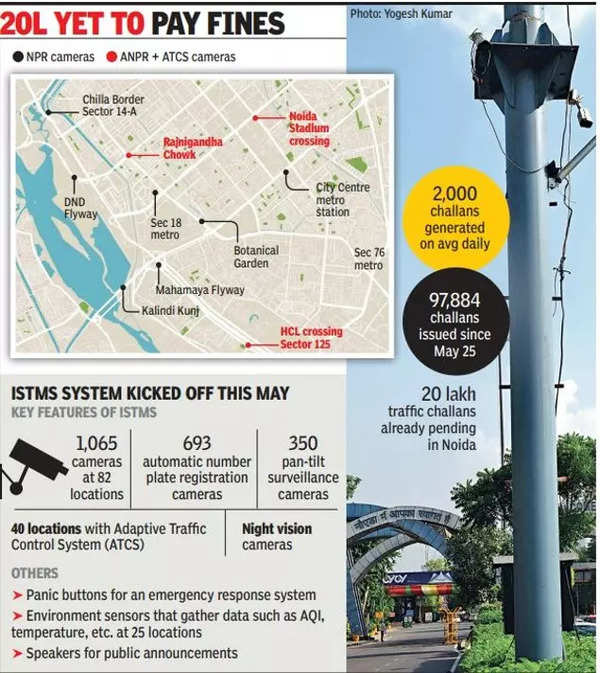Since May 25, a network of cameras powered by artificial intelligence and connected to a control room have been issuing fines to commuters breaking the rules. Close to 100,000 challans – 2,000 on average every day – have been given out since the Integrated Security and Traffic Management System (ISTMS) went online four months back.
ISTMS is fully functional at 82 locations. It is equipped with 1,065 cameras, including 693 automatic number plate recognition cameras, adaptive traffic light systems at 40 locations, 350 surveillance cameras and four speed detection cameras.

There are also robust emergency alert systems with panic buttons and public address systems for announcements. Noida traffic police say the use of ISTMS has helped drill road hygiene.
For instance, police said on Sunday, if a commuter halts one’s car in the middle of a road and blocks traffic, an announcement will be made to warn the driver of XYZ (registration number) to move the vehicle or face action. This will be done without a traffic cop deployed on site; officials at the control room in Sector 94 make this announcement.
“The results were quick when I asked a commuter near Botanical Garden to remove his vehicle from the road,” Ganesh Prasad Saha, Noida DCP (traffic), told TOI.
Tracking violations
To keep track of violations, there are 693 automatic number-plate recognition (ANPR) cameras at all the 82 locations where the ISTMS has been implemented. These include metro stations in sectors 18, 52, 51, 62, and City Centre apart from Prateek Wisteria crossing, Mahamaya Flyway, Noida-Delhi border at Chilla, DND Flyway and the elevated road from the elevated road from Sector 27 to Sector 61.
“These cameras record violations such as jumping red lights, driving without helmets, triple riding on two-wheelers, wrong-side driving, speeding, etc,” said an official of EFKON India, the company that is managing the project.
Residents agreed. Brajesh Kumar Sharma, who lives in Antriksh Golf View in Sector 78, said he was on way home when he heard a public announcement on wearing seatbelts. “I saw some commuters fasten their seatbelts,” he said.
During a visit to the ISTMS control room on Monday, a group of five women traffic police personnel were mining data and facilitating challans. “ANPR cameras catch the number plates and automatically fetch vehicles’ registration details. We then verify and log it into a website. A challan is immediately generated,” said constable and ITMS staff Pooja Upadhyaya.
Streamlining traffic
The other major use of the ISTMS is the adaptive traffic control system (ADCS) at 40 locations such as Metro Hospital in Sector 11, Pathways School in Sector 100, Noida Stadium, Rajnigandha Chowk, Adobe crossing and Hajipur (Sector 104).
“ADCS automatically changes traffic lights depending on the volume of commuters on a stretch,” the DCP said.
Noida traffic inspector Ashutosh Singh added that the ISTMS is easing movement within the city. “We also used the system in effectively and safely enabling the Kanwar Yatra this year,” Singh said.
There are also some secondary uses of ISTMS. At least 78 surveillance cameras are mounted at all the ISTMS locations. The footage from these cameras is meant to be used by cops for investigation into crimes. Moreover, there are panic buttons and environment sensors at 25 locations.
The shortcomings
Cameras under ISTMS cannot capture violations like not wearing seatbelts or using a mobile phone while driving. For this, the cameras need to be mounted at a low height, an official told TOI.
Similarly, traffic police personnel work from 9am to 5pm daily, which means some of the challans — though caught on camera — aren’t issued until the staff goes through them.
A larger issue may also be that Noida had 20 lakh challans issued before ISTMS that are yet to be paid up by the violators, according to data by the traffic police.






